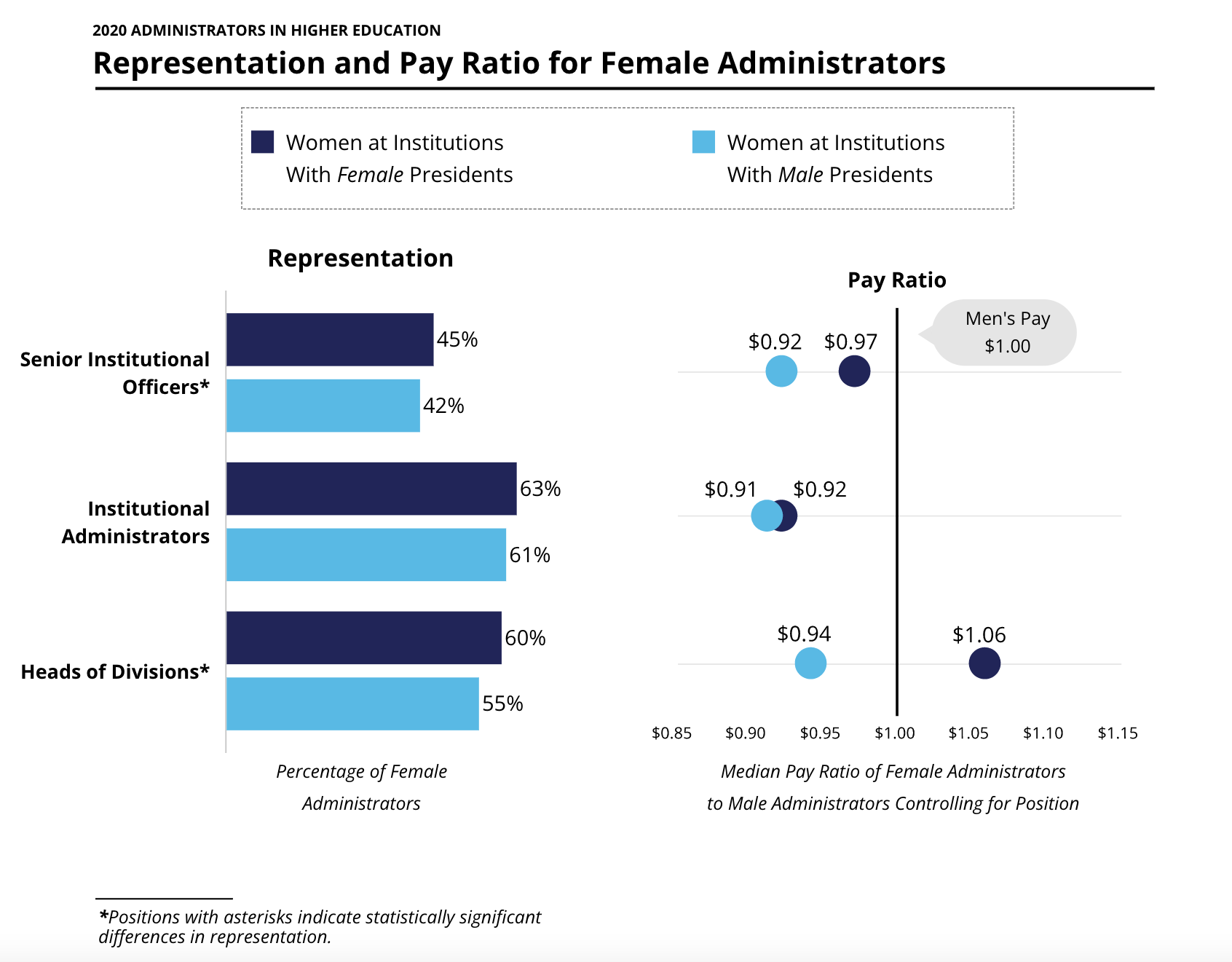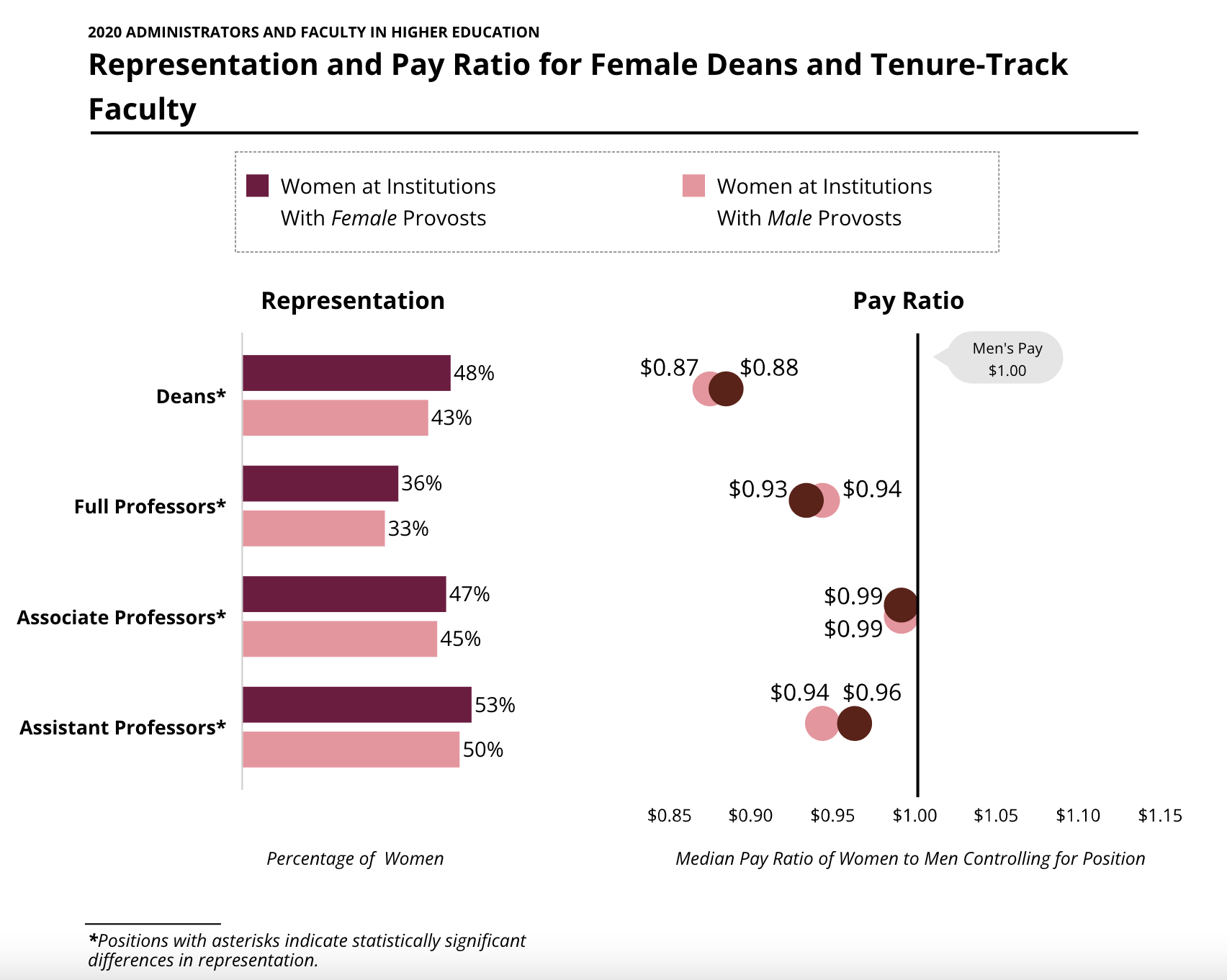You have /5 articles left.
Sign up for a free account or log in.

Colleges and universities with female presidents have higher percentages of women in all top administrative categories.
Hiraman/Getty Images
Female senior faculty and top administrators earn more at institutions with female presidents and provosts than at institutions where men are in charge, a new analysis from the College and University Professional Association for Human Resources shows.
Nearly one-third—32 percent—of colleges and universities have female presidents, according to CUPA-HR data. For every dollar male presidents earn, female presidents earn $0.91.
The analysis relies on data from CUPA-HR’s 2020 Administrators in Higher Education survey, as well as the 2020 Faculty in Higher Education Survey, which includes information about 47,985 administrators and 171,367 tenure-track faculty members, respectively. For this particular analysis, the authors looked at 925 institutions that provided information about the genders of their presidents and other administrators and faculty.
Colleges and universities with female presidents have higher percentages of women in all top administrative categories, including senior institutional officers, institutional administrators and division heads, according to the analysis.
Forty-five percent of senior officers at female-led institutions are women, compared with 42 percent at male-led institutions. Six in 10 division heads—which includes roles like bursar, chief campus bookstore administrator and chief student housing administrator—at female-led institutions are women, compared with 55 percent at male-led institutions. And about 63 percent of administrators—such as chief diversity officers and chief purchasing officers—at female-led institutions are women, while only 61 percent of administrators at male-led institutions are women.
 Regardless of whether an institution has a female or male president, female administrators are typically paid less than men. That said, female administrators at institutions with a female president earn more than their counterparts at institutions with male presidents, the data showed.
Regardless of whether an institution has a female or male president, female administrators are typically paid less than men. That said, female administrators at institutions with a female president earn more than their counterparts at institutions with male presidents, the data showed.
For every dollar a man makes, female senior officers at male-led colleges earn $0.92, while female senior officers at female-led colleges earn $0.97. Female administrators at male-led colleges earn $0.91 for every dollar their male counterparts earn, while female administrators at female-led colleges earn $0.92.
The pay gap among female division heads breaks away quite a bit: for every dollar a male division head earns, female division heads at male-led colleges earn $0.94, while female division heads at female-led colleges earn $1.06.
Good compensation packages should include more than just a competitive salary, said Marjorie Hass, president of the Council of Independent Colleges. Benefits, paid leave, opportunities for advancement and “matching authority to responsibility” are important to women when considering a job.
“One of the things that I hear most often from women—and this is why it’s often a little bit hard to even compare job titles and pay—is that their roles have a great deal more responsibility than their job title would tell,” Hass said. “In other words, they may be an assistant provost or an associate provost, but they’re doing work that would normally be included in the provost position, without the title and thus without the salary.”
Women are slightly more represented among provosts than presidents—44 percent of provosts are women, according to the CUPA-HR analysis.
At institutions with female provosts, 48 percent of deans are women, compared to 43 percent at institutions with male provosts. Women make up 53 percent of assistant professors at institutions with female provosts and 50 percent of assistant professors at institutions with male provosts. Among associate professors, 47 percent are women at institutions with female provosts, while 45 percent are women at institutions with male provosts.
 The percentage of women drops off at the full professor level, regardless of the provost’s gender. About 36 percent of full professors at institutions with female provosts are women, and 33 percent at institutions with male provosts are women.
The percentage of women drops off at the full professor level, regardless of the provost’s gender. About 36 percent of full professors at institutions with female provosts are women, and 33 percent at institutions with male provosts are women.
The stark difference in the number of women in entry-level and senior faculty ranks likely accounts for the lack of women in leadership positions, said Jackie Bichsel, director of research at CUPA-HR.
“It really starts with the faculty,” Bichsel said. “The path to the president and provost positions is paved by the dean and senior faculty. One of the reasons you do not have a female president and provost is that there are not enough women in that pipeline because women are not being promoted up through the faculty ranks.”
One-third of presidents served as provost or vice provost just before being appointed president, according to the CUPA-HR analysis. One-quarter of presidents were presidents at another institution immediately prior to their current presidential role. Nearly half of all provosts were deans, a quarter were vice provosts and 14 percent were provosts at another institution before assuming their current role.
Most promotion decisions are made at the department level, Bichsel said. While many institutions do have policies to prevent discrimination in hiring, many of those policies are too vague and allow tenure and promotion committees to make decisions based on gut feelings rather than objective criteria.
“When you add all that to the implicit expectations and roadblocks that women faculty are expected to hurdle as they go through the promotion process—like higher expectations of service, work, childcare, that sort of thing … you have a recipe for disaster as far as allowing discrimination to set in,” she said.
Some university policies designed to prevent this kind of discrimination can have the opposite effect, Hass said. She looked at paid parental leave as an example.
“There are opportunities for pregnant people to stop the tenure clock because pregnancy and nurturing a newborn child interfere with research productivity,” Hass said. “As those policies have expanded into parental leave policies, there’s anecdotal evidence that the nonpregnant parent may be taking that leave time as well but actually using that not for childcare but to create and produce additional research. Even policies that may look like they are creating equality may inadvertently create unequal results.”
The study doesn’t address why women earn more under female presidents, but Angela Onwuachi-Willig, dean and professor of law at the Boston University School of Law, speculated that women in leadership roles keep issues like pay equity top of mind.
“Who is in leadership matters, because they’re more likely to see issues that might be invisible to somebody who didn’t share a particular identity,” she said. “For example, I have a female provost, and one of the things that she regularly mentions in meetings is issues of pay equity. She gives us equity dollars when we’re doing our merit raises.”
It’s also possible that institutions with greater pay equity and more women in the top ranks are more likely to hire female provosts and presidents, Onwuachi-Willig said. To know if that’s the case, she would need to see additional research about what pay levels looked like before a female president or provost took the helm.
Hass would like to see research on women in higher education that looks at exactly what tasks they take on in each role, how they’re compensated for those job duties and how institutions implement policies to encourage and support more women in leadership.
The research “needs to look broadly at these kinds of issues, particularly the impact COVID-19 has had,” Hass said. “I really applaud CUPA-HR for taking this step and releasing this kind of research, and I encourage other research organizations to do the same.”








